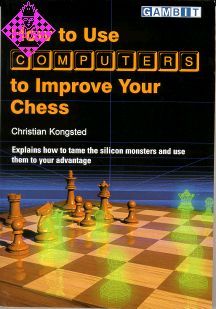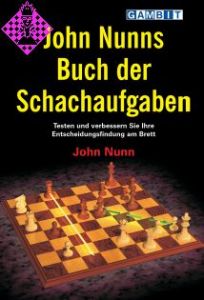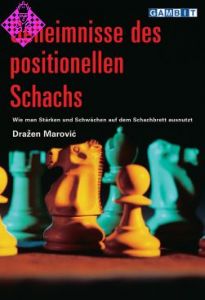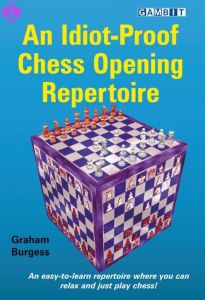Artikelnummer
LXKONHTUCTIYC
Autor
How to use computers to improve your chess
192 Seiten, kartoniert, Gambit, 2003
Final vergriffen
Computers have permeated almost every facet of modern chess, yet few players know how to gain the maximum benefit from working with them. Computers function as playing partners, opening study tools, endgame 'oracles', tactics trainers, sources of information on opponents and searchable game databases. Kongsted provides practical advice on how to use computers in all these ways and more. He also takes a look at the history of the chess computer, and how its 'thinking' methods have developed since the early days. The book features an investigation of human vs. machine contests, including the recent Kasparov vs. Deep Junior and Kramnik vs. Deep Fritz matches, in which honours ended even.
This book is aimed at players who are interested in improving their chess and want to get some advice on how to use a computer to achieve this aim. Personally, I have been interested in computer chess since 1982, when I was ten years old and my father gave me my first chess computer. It was a Fidelity Chess Challenger about the size of a pocket chess board, and it had two diodes, one for 'Check' and one for 'I lose'. While it was thinking, the light switched between these two diodes until it finally made a move, and I remember being fascinated by looking at the diodes. One move before being checkmated the computer would usually realize that it was losing and light up the 'I lose' diode.
By modern standards the Chess Challenger was laughably weak, and within a year it had stopped being a challenging opponent for a 10-year-old boy. Fortunately, the development of the computers seemed to fit my own development as a child. Some years later I got a Novag Super Constellation chess computer, which was much stronger than the Chess Challenger and allegedly played at an Elo level around 1600-1700. I battled with it for some years, and later, in 1992 my father bought a Mephisto Amsterdam, which was probably 300-400 Elo points stronger again. In those ten years the computers had improved by nearly 1000 points and the development was still going on. Chess computers were getting stronger and stronger.
During the 1990s, I had a long pause from tournament chess, and when I came back to the chess world around 1999, everything had changed. In the 1980s and early 1990s, I believe people were mostly using computer programs for playing some occasional games, and at that time the fight between club players and computers was still more or less equal.
Now computers can be used for a lot of things apart from just playing. Databases have made it a lot easier to prepare for a game and study openings. Internet chess clubs have popped up, and chess programs have achieved a strength comparable to that of a grandmaster.
I became interested in the many possibilities and started to search for some books about how to get the best out of the new tools. To my surprise, I found no literature that covered the question in a satisfying way. Only a few books included a chapter about this subject.
Just then I felt like I had stumbled upon a gap in chess literature, which I have now attempted to fill. I believe the issue of chess and computers deserves more than a chapter in a book. For the serious chess-player, the computer is currently the most important companion (maybe except for board and pieces!). Only a very small number of players in the world elite get by without making use of the new possibilities.
My own serious experiments with computer analysis started when I took part in some correspondence chess tournaments. During games in the ICCF (International Correspondence Chess Federation) Master Class I realized that most players seemed to be very 'inspired' by the computer. Often it looked like they would just play the move Fritz suggested, even in positions where the program was of no use. In correspondence chess circles these players are called 'postmen', because their main function is to send the move that some program has calculated for them.
After playing in some correspondence chess tournaments, I felt that there was a serious need for a discussion about how to use a computer program as a partner in analysis. During this period I gradually developed a better understanding of the strengths and weaknesses of computer play, and I have now used my knowledge in writing this book.
The main problem when using computer programs for playing or analysis is that they do not explain anything to
you. They just take your pieces if you put them en prise. Even though their strength is impressive, it is not at all obvious how the average chess-player can use them for improvement. Thus, I seek to answer exactly this question on these pages.
I have divided the book into two main parts. Part 1 is mainly about how computer programs work. After a brief historical overview in Chapter 1, the second and third chapters give some insights into how computers 'think'. The information in this chapter will be useful later. For instance, when performing computer-assisted analysis, it is of great importance to have some knowledge of the processes that lead a computer to recommend a certain move. Especially Chapter 3, about the weaknesses of the computers, will give a better idea of when to trust computer analysis and when to rely more on one's own intuition. Finally in Chapter 4, I have included a discussion of how to beat computer programs. Knowledge of the computer's weaknesses described in Chapter 3 is clearly an essential basis for having any chance of beating a modern computer program.
In Part 2, I concentrate on how to improve various aspects of one's own play with the help of the computer. First of all, in Chapter 5 I present an overview of some of the software available, and in Chapter 6 there is a discussion of how to use the combined forces of the human brain and a chess
program for performing computer-assisted analysis. Chapters 7-9 focus on how to improve various areas of one's play by using databases and by means of playing out positions against the computer. Chapter 10 is about Internet chess and how to integrate this in chess training, and finally in Chapter 11, a few words about chess and computers in the future.
For ease of reference, I have used ChessBase programs for the examples throughout the book. This does in no way mean that alternative programs are inferior. Other companies like Convekta (Chess Assistant), Lokasoft (Chess Tiger) and Ubisoft (Chessmaster) have products which are of similar quality. The reason why I have included these examples is that I would like this book to be a useful and concrete guide, and I did not want to leave the reader without any clue as to how to perform specific operations with a chess program. Most modern computer programs come without a really good manual, and this leaves the user to explore things for himself by using the help files in the program. I believe that there is a need for better guidance than that. However, a detailed explanation of all programs and their functions would have been too space-consuming, and it is also most unlikely that the book would have been very interesting if I had done that. Thus, I hope the reader will understand and appreciate this arrangement.
I would like to thank my family and my girlfriend Michela Tenze for supporting me during my work with this book, helping me reading the proofs and commenting on the manuscript. During my work I have also had the pleasure of meeting the Danish programmer Steen Suurballe and to play and analyse with his excellent program Gandalf. Our discussions about computer chess have been going on for months and they have given me a lot of insight into the possibilities and limitations that exist in the fascinating world of computer chess. I am sure that this has made the book a much more interesting read. Moreover, I would like to thank my editor Graham Burgess for giving me the possibility of writing this book and for a productive dialogue about which topics to include in this book and how to deal with them.
Finally, I should mention that I have used a computer with an AMD 850 MHz processor and 640 Mb RAM, with 256 Mb RAM used for hash tables for all computer test examples in this book.
Christian Kongsted, Copenhagen, March 2003
This book is aimed at players who are interested in improving their chess and want to get some advice on how to use a computer to achieve this aim. Personally, I have been interested in computer chess since 1982, when I was ten years old and my father gave me my first chess computer. It was a Fidelity Chess Challenger about the size of a pocket chess board, and it had two diodes, one for 'Check' and one for 'I lose'. While it was thinking, the light switched between these two diodes until it finally made a move, and I remember being fascinated by looking at the diodes. One move before being checkmated the computer would usually realize that it was losing and light up the 'I lose' diode.
By modern standards the Chess Challenger was laughably weak, and within a year it had stopped being a challenging opponent for a 10-year-old boy. Fortunately, the development of the computers seemed to fit my own development as a child. Some years later I got a Novag Super Constellation chess computer, which was much stronger than the Chess Challenger and allegedly played at an Elo level around 1600-1700. I battled with it for some years, and later, in 1992 my father bought a Mephisto Amsterdam, which was probably 300-400 Elo points stronger again. In those ten years the computers had improved by nearly 1000 points and the development was still going on. Chess computers were getting stronger and stronger.
During the 1990s, I had a long pause from tournament chess, and when I came back to the chess world around 1999, everything had changed. In the 1980s and early 1990s, I believe people were mostly using computer programs for playing some occasional games, and at that time the fight between club players and computers was still more or less equal.
Now computers can be used for a lot of things apart from just playing. Databases have made it a lot easier to prepare for a game and study openings. Internet chess clubs have popped up, and chess programs have achieved a strength comparable to that of a grandmaster.
I became interested in the many possibilities and started to search for some books about how to get the best out of the new tools. To my surprise, I found no literature that covered the question in a satisfying way. Only a few books included a chapter about this subject.
Just then I felt like I had stumbled upon a gap in chess literature, which I have now attempted to fill. I believe the issue of chess and computers deserves more than a chapter in a book. For the serious chess-player, the computer is currently the most important companion (maybe except for board and pieces!). Only a very small number of players in the world elite get by without making use of the new possibilities.
My own serious experiments with computer analysis started when I took part in some correspondence chess tournaments. During games in the ICCF (International Correspondence Chess Federation) Master Class I realized that most players seemed to be very 'inspired' by the computer. Often it looked like they would just play the move Fritz suggested, even in positions where the program was of no use. In correspondence chess circles these players are called 'postmen', because their main function is to send the move that some program has calculated for them.
After playing in some correspondence chess tournaments, I felt that there was a serious need for a discussion about how to use a computer program as a partner in analysis. During this period I gradually developed a better understanding of the strengths and weaknesses of computer play, and I have now used my knowledge in writing this book.
The main problem when using computer programs for playing or analysis is that they do not explain anything to
you. They just take your pieces if you put them en prise. Even though their strength is impressive, it is not at all obvious how the average chess-player can use them for improvement. Thus, I seek to answer exactly this question on these pages.
I have divided the book into two main parts. Part 1 is mainly about how computer programs work. After a brief historical overview in Chapter 1, the second and third chapters give some insights into how computers 'think'. The information in this chapter will be useful later. For instance, when performing computer-assisted analysis, it is of great importance to have some knowledge of the processes that lead a computer to recommend a certain move. Especially Chapter 3, about the weaknesses of the computers, will give a better idea of when to trust computer analysis and when to rely more on one's own intuition. Finally in Chapter 4, I have included a discussion of how to beat computer programs. Knowledge of the computer's weaknesses described in Chapter 3 is clearly an essential basis for having any chance of beating a modern computer program.
In Part 2, I concentrate on how to improve various aspects of one's own play with the help of the computer. First of all, in Chapter 5 I present an overview of some of the software available, and in Chapter 6 there is a discussion of how to use the combined forces of the human brain and a chess
program for performing computer-assisted analysis. Chapters 7-9 focus on how to improve various areas of one's play by using databases and by means of playing out positions against the computer. Chapter 10 is about Internet chess and how to integrate this in chess training, and finally in Chapter 11, a few words about chess and computers in the future.
For ease of reference, I have used ChessBase programs for the examples throughout the book. This does in no way mean that alternative programs are inferior. Other companies like Convekta (Chess Assistant), Lokasoft (Chess Tiger) and Ubisoft (Chessmaster) have products which are of similar quality. The reason why I have included these examples is that I would like this book to be a useful and concrete guide, and I did not want to leave the reader without any clue as to how to perform specific operations with a chess program. Most modern computer programs come without a really good manual, and this leaves the user to explore things for himself by using the help files in the program. I believe that there is a need for better guidance than that. However, a detailed explanation of all programs and their functions would have been too space-consuming, and it is also most unlikely that the book would have been very interesting if I had done that. Thus, I hope the reader will understand and appreciate this arrangement.
I would like to thank my family and my girlfriend Michela Tenze for supporting me during my work with this book, helping me reading the proofs and commenting on the manuscript. During my work I have also had the pleasure of meeting the Danish programmer Steen Suurballe and to play and analyse with his excellent program Gandalf. Our discussions about computer chess have been going on for months and they have given me a lot of insight into the possibilities and limitations that exist in the fascinating world of computer chess. I am sure that this has made the book a much more interesting read. Moreover, I would like to thank my editor Graham Burgess for giving me the possibility of writing this book and for a productive dialogue about which topics to include in this book and how to deal with them.
Finally, I should mention that I have used a computer with an AMD 850 MHz processor and 640 Mb RAM, with 256 Mb RAM used for hash tables for all computer test examples in this book.
Christian Kongsted, Copenhagen, March 2003
| EAN | 9781904600022 |
|---|---|
| Gewicht | 260 g |
| Hersteller | Gambit |
| Breite | 14,5 cm |
| Höhe | 21 cm |
| Medium | Buch |
| Erscheinungsjahr | 2003 |
| Autor | Christian Kongsted |
| Sprache | Englisch |
| ISBN-10 | 1904600026 |
| ISBN-13 | 9781904600022 |
| Seiten | 192 |
| Einband | kartoniert |
005 Symbols
007 Introduction
Part 1: How the Computer Works
010 1 The History of Computer Chess
011 The First Mechanical Machine
013 Early Developments
014 Haunted by 'Bugs'
014 A Computer Program Becomes a Master
015 Playing the World Champ
016 Mount Everest Grows
017 The Legend of Deep Blue
019 2 Inside the Machine
021 The Search Tree
023 The Alpha-Beta Algorithm and Extensions
025 'Gimme Your Best Shot!' - The Null-Move
030 Razoring
030 The Evaluation Function
034 The Engine Output
035 3 The Blind Spots of the Computer
037 Positional Problems Deriving from the 'Horizon Effect'
039 Building Fortresses
044 Materialism and King Safety
043 More on Sacrifices
051 Aggression and Lack of Planning
054 Closed Positions
060 Activity of the Pieces
062 Zugzwang Positions
065 Lack of Endgame Knowledge
066 Positional Evaluation and Exceptions from Rules
069 The Good, the Bad and the Active Bishop
072 4 How to Beat Your Computer
073 Anti-Computer Strategies
081 The Computer's Opening Book
082 Openings and Move-Orders for White
084 Game Examples for White
089 Openings and Move-Orders for Black
091 Game Examples for Black
101 Summary of Anti-Computer Strategy
Part 2: Improving with the Computer
104 5 Hardware, Software and Databases
105 Databases
107 Database Programs
110 Playing Programs
111 Alternatives to ChessBase Programs
113 Optimizing the Program
115 'Handicapping' the Program
117 Tutorial Programs and Opening CDs
117 Computer Hardware
118 Electronic Chessboards
120 6 Computer-Assisted Analysis
121 Expanding the Horizon
124 Playing out Positional Plans
126 Automatic Computer Analysis
131 Analysing Your Games with the Computer
134 7 Improving Your Opening Play
135 Constructing Your Own Databases
136 Studying Opening and Middlegame Ideas
138 The 'Opening Report'
140 The Repertoire Database
143 Transpositions
144 Checking Variations and Creating Novelties
146 Learning a New Opening
149 8 Improve Your Tactics
150 Play out Exercises
153 Solutions
159 9 Improve Your Endgame Technique
160 Playing Out Endgame Positions
165 Playout Exercises
169 Solutions
178 10 Playing Chess on the Internet
179 A Few Search Tips for ICC
181 11 Computer Chess in the Future
184 Bookmarks on the Internet
188 Bibliography
190 Index of Games
192 Index of Composers/Analysts
192 Index of Openings
007 Introduction
Part 1: How the Computer Works
010 1 The History of Computer Chess
011 The First Mechanical Machine
013 Early Developments
014 Haunted by 'Bugs'
014 A Computer Program Becomes a Master
015 Playing the World Champ
016 Mount Everest Grows
017 The Legend of Deep Blue
019 2 Inside the Machine
021 The Search Tree
023 The Alpha-Beta Algorithm and Extensions
025 'Gimme Your Best Shot!' - The Null-Move
030 Razoring
030 The Evaluation Function
034 The Engine Output
035 3 The Blind Spots of the Computer
037 Positional Problems Deriving from the 'Horizon Effect'
039 Building Fortresses
044 Materialism and King Safety
043 More on Sacrifices
051 Aggression and Lack of Planning
054 Closed Positions
060 Activity of the Pieces
062 Zugzwang Positions
065 Lack of Endgame Knowledge
066 Positional Evaluation and Exceptions from Rules
069 The Good, the Bad and the Active Bishop
072 4 How to Beat Your Computer
073 Anti-Computer Strategies
081 The Computer's Opening Book
082 Openings and Move-Orders for White
084 Game Examples for White
089 Openings and Move-Orders for Black
091 Game Examples for Black
101 Summary of Anti-Computer Strategy
Part 2: Improving with the Computer
104 5 Hardware, Software and Databases
105 Databases
107 Database Programs
110 Playing Programs
111 Alternatives to ChessBase Programs
113 Optimizing the Program
115 'Handicapping' the Program
117 Tutorial Programs and Opening CDs
117 Computer Hardware
118 Electronic Chessboards
120 6 Computer-Assisted Analysis
121 Expanding the Horizon
124 Playing out Positional Plans
126 Automatic Computer Analysis
131 Analysing Your Games with the Computer
134 7 Improving Your Opening Play
135 Constructing Your Own Databases
136 Studying Opening and Middlegame Ideas
138 The 'Opening Report'
140 The Repertoire Database
143 Transpositions
144 Checking Variations and Creating Novelties
146 Learning a New Opening
149 8 Improve Your Tactics
150 Play out Exercises
153 Solutions
159 9 Improve Your Endgame Technique
160 Playing Out Endgame Positions
165 Playout Exercises
169 Solutions
178 10 Playing Chess on the Internet
179 A Few Search Tips for ICC
181 11 Computer Chess in the Future
184 Bookmarks on the Internet
188 Bibliography
190 Index of Games
192 Index of Composers/Analysts
192 Index of Openings
Chess computers and chess programmes for the PC are to be found in abundance, but few owners make full use of all their possibilities. The professed aim of this book is to remedy this situation. The author, a Danish chess journalist and more than competent chess player, has made a detailed study of the whole field of chess and computers, and this book aims to fill a gap in the market.
The author clearly has an intimate knowledge of the whole subject, and the book contains a wealth of information on all aspects of the topic. Part One, How the Computer Works, delves into the history of computer chess, explains how chess programmes work, how they calculate moves, looks at their blind spots, such as the horizon effect, materialism and sacrifices, their lack of endgame knowledge, and finally applies this knowledge in discussing how to beat computers.
Part Two, Improving With the Computer, starts with a survey of hardware, software and databases, then goes on to explain how to make optimum use of the computer in analysis. There are then chapters on how to improve your opening play, tactics and endgame technique. In his final chapter the author gazes into his crystal ball to look into the future of computer chess. There are also four pages of useful web addresses.
However much we may deplore the introduction of computers as foreshadowing the demise of chess as we know it, we have to accept that they are here to stay and we cannot bury our heads in the sand and pretend that it is all a bad dream. The author is very much a pragmatist, who has learnt how to exploit the potential of the silicon monster to the full. There is a wealth of information and advice contained within the pages of the book to help you do likewise. It makes for fascinating reading.
Alan Sutton, "En Passant"
The author clearly has an intimate knowledge of the whole subject, and the book contains a wealth of information on all aspects of the topic. Part One, How the Computer Works, delves into the history of computer chess, explains how chess programmes work, how they calculate moves, looks at their blind spots, such as the horizon effect, materialism and sacrifices, their lack of endgame knowledge, and finally applies this knowledge in discussing how to beat computers.
Part Two, Improving With the Computer, starts with a survey of hardware, software and databases, then goes on to explain how to make optimum use of the computer in analysis. There are then chapters on how to improve your opening play, tactics and endgame technique. In his final chapter the author gazes into his crystal ball to look into the future of computer chess. There are also four pages of useful web addresses.
However much we may deplore the introduction of computers as foreshadowing the demise of chess as we know it, we have to accept that they are here to stay and we cannot bury our heads in the sand and pretend that it is all a bad dream. The author is very much a pragmatist, who has learnt how to exploit the potential of the silicon monster to the full. There is a wealth of information and advice contained within the pages of the book to help you do likewise. It makes for fascinating reading.
Alan Sutton, "En Passant"
Der 31-jährige dänische JournaIist und sehr gute Fernschachspieler Christian Kongsted (Nahschach-Elo 2280) möchte in seinem frisch erschienenen Buch zeigen, wie man mit Hilfe des Computers das eigene Schachspiel verbessern kann. Er erweist sich dabei als profunder Kenner der Materie. Alle der letzten hochkarätigen Matches zwischen Mensch und Computer samt den im Zusammenhang damit meist diskutierten Stellungen und Strategien sind berücksichtigt, Kongsted bringt Analysebeispiele neuester Engines (z.B. Shredder 7.04) und verfügt ganz offensichtlich, wie seine abgewogenen Erläuterungen und Einschätzungen zu einzelnen Programmen bzw. Schachengines zeigen, über umfassende Detailkenntnisse am Schachsoftwaremarkt. Der Autor geht zunächst auf die Geschichte des Computerschachs ein, erklärt anschaulich wesentliche »Denkvorgänge« der Siliziumhirne, erläutert - trotz der in Wettkämpfen und Turnieren unbestritten bewiesenen Großmeisterstärke - die immer noch vorhandenen prinzipiellen Schwächen der Programme. Dabei beleuchtet er folgende Themenkreise: Horizont-Effekt; Bau von Festungen; Materialismus und Königssicherheit; mangelnde Langzeitplanung; geschlossene Stellungen; Aktivität der Figuren; Zugzwangstellungen; mangelndes Endspielwissen; Ausnahme von allg. Regeln; guter, schlechter, aktiver Läufer. Weiterhin geht er auf Spielstrategien und Eröffnungssysteme ein, die helfen, als Mensch in Partien gegen Programme am besten bestehen zu können. Im zweiten Hauptteil des Buches geht es um den Umgang mit Schachdatenbanken; der Autor gibt ausführlich Tipps zur computerunterstützten Stellungs- und Partieanalyse sowie zur Arbeit an der Verbesserung des eigenen Eröffnungsrepertoires, der taktischen Schlagfertigkeit und der Endspielstärke. Ein Abschnitt zum Spielen im Internet, ein Ausblick zum Computerschach in der Zukunft und eine sehr ausführliche und gut gegliederte Linkliste zur weiteren Suche im Internet runden das Buch ab. Sehr instruktiv sind auch die Teststellungen mit Stellungsvorteil, die man zum Training gegen ein Programm ausspielen sollte (vgl. dazu die ChessBase-CD »Techniktrainer«).
Dies alles in sehr gut verständlichem Englisch, anschaulich und mit didaktischem Blick dargeboten und mit vielen ausführlich analysierten Stellungs- und Partiebeispielen untermauert. Wer zur Verbesserung seines eigenen Schachspiels den Computer einsetzen möchte, wird hier eine Fülle von Anregungen und auch Einsichten in die Arbeitsweise der Maschinen erhalten. Der Band, der mir sehr viel Lesevergnügen bereitet hat, ist gleichzeitig, obwohl nicht direkt beabsichtigt, auch als generelle und sehr aktuelle Einführung in das Themengebiet »Computerschach« geeignet. Ein rundherum empfehlenswertes Buch!
Helmut Conrady, Rochade Europa 11/2003
vergleichende Rezension der Titel:
Jacobs/Aagaard/Emms: Chess Software User's Guide
Christian Kongsted: How to Use Computers to Improve Your Chess,
Praktisch zeitgleich haben die beiden Londoner Konkurrenzverlage Leitfäden zum Umgang mit Schachprogrammen herausgegeben. Der User's Guide fällt eindeutig unter die Kategorie „Überteuerter Schnellschuss". Die 128 groß bedruckten Seiten, einspaltig und gestreckt mit etlichen Screenshots, bewegen sich auf dem Niveau eines mittleren Benutzerhandbuches für ChessBase. Selbst das mag dem User das Geld wert sein, falls er mit der ChessBase-eigenen Hilfe nicht klar kommt. Doch zuvor sollte er auf die Internetseite www.schachvereine.de/scleinzell/ schauen, wo es mindestens ebenso viele und gute Tipps gratis gibt. Kritische Gedanken zum Thema oder etwa den Vergleich verschiedener Produkte gibt es nur ansatzweise und alibihaft.
Wesentlich anspruchsvoller ist Kongsteds Buch. Der Autor ist u. a. ein starker Fernschachspieler (FS-Elo 2510) und gibt einen differenzierteren Einblick in die Materie. Themen sind die Geschichte des Computerschachs, Grundlegendes zum Programmieren und zum „Denken" von Computern, „Blinde Flecken" (ein humorvolles Kapitel, das zeigt, wie auch heutige Spitzenprogramme völlig danebenliegen können), Anti-Computer-Strategien und Tipps zum Training mit Computern. Dann Gedanken zu verschiedenen Produkten (neben ChessBase und ChessAssistant werden auch nützliche Tools wie Bookilp erwähnt) und die Charakterisierung der Spitzenprogramme. Vor allem für Fernschachspieler dürften Hinweise wie „Hiarcs ist das stärkste Programm zum Analysieren von Turmendspielen" nützlich sein. Das Buch schließt mit kurzen Hinweisen zum Internetschach bzw. ICC sowie einem ausführlichen Internet-Adressbuch mit Links zu Seiten für Schachcomputerfreaks.
Insgesamt wendet sich das Buch an den schon recht erfahrenen Anwender. Grundlegende Arbeitstechniken werden, im Unterschied zum User's Guide, bereits vorausgesetzt, und es gibt keinerlei Abbildungen. Durchaus noch steigerungsfähig, aber insgesamt empfehlenswert.
Harald Keilhack, Schach 01/2004
Dies alles in sehr gut verständlichem Englisch, anschaulich und mit didaktischem Blick dargeboten und mit vielen ausführlich analysierten Stellungs- und Partiebeispielen untermauert. Wer zur Verbesserung seines eigenen Schachspiels den Computer einsetzen möchte, wird hier eine Fülle von Anregungen und auch Einsichten in die Arbeitsweise der Maschinen erhalten. Der Band, der mir sehr viel Lesevergnügen bereitet hat, ist gleichzeitig, obwohl nicht direkt beabsichtigt, auch als generelle und sehr aktuelle Einführung in das Themengebiet »Computerschach« geeignet. Ein rundherum empfehlenswertes Buch!
Helmut Conrady, Rochade Europa 11/2003
vergleichende Rezension der Titel:
Jacobs/Aagaard/Emms: Chess Software User's Guide
Christian Kongsted: How to Use Computers to Improve Your Chess,
Praktisch zeitgleich haben die beiden Londoner Konkurrenzverlage Leitfäden zum Umgang mit Schachprogrammen herausgegeben. Der User's Guide fällt eindeutig unter die Kategorie „Überteuerter Schnellschuss". Die 128 groß bedruckten Seiten, einspaltig und gestreckt mit etlichen Screenshots, bewegen sich auf dem Niveau eines mittleren Benutzerhandbuches für ChessBase. Selbst das mag dem User das Geld wert sein, falls er mit der ChessBase-eigenen Hilfe nicht klar kommt. Doch zuvor sollte er auf die Internetseite www.schachvereine.de/scleinzell/ schauen, wo es mindestens ebenso viele und gute Tipps gratis gibt. Kritische Gedanken zum Thema oder etwa den Vergleich verschiedener Produkte gibt es nur ansatzweise und alibihaft.
Wesentlich anspruchsvoller ist Kongsteds Buch. Der Autor ist u. a. ein starker Fernschachspieler (FS-Elo 2510) und gibt einen differenzierteren Einblick in die Materie. Themen sind die Geschichte des Computerschachs, Grundlegendes zum Programmieren und zum „Denken" von Computern, „Blinde Flecken" (ein humorvolles Kapitel, das zeigt, wie auch heutige Spitzenprogramme völlig danebenliegen können), Anti-Computer-Strategien und Tipps zum Training mit Computern. Dann Gedanken zu verschiedenen Produkten (neben ChessBase und ChessAssistant werden auch nützliche Tools wie Bookilp erwähnt) und die Charakterisierung der Spitzenprogramme. Vor allem für Fernschachspieler dürften Hinweise wie „Hiarcs ist das stärkste Programm zum Analysieren von Turmendspielen" nützlich sein. Das Buch schließt mit kurzen Hinweisen zum Internetschach bzw. ICC sowie einem ausführlichen Internet-Adressbuch mit Links zu Seiten für Schachcomputerfreaks.
Insgesamt wendet sich das Buch an den schon recht erfahrenen Anwender. Grundlegende Arbeitstechniken werden, im Unterschied zum User's Guide, bereits vorausgesetzt, und es gibt keinerlei Abbildungen. Durchaus noch steigerungsfähig, aber insgesamt empfehlenswert.
Harald Keilhack, Schach 01/2004
Mehr von Gambit
-
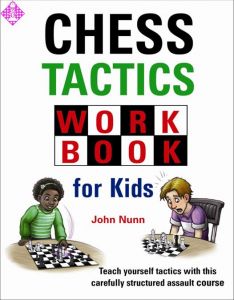 Chess Tactics Workbook for Kids16,95 €
Chess Tactics Workbook for Kids16,95 € -
 101 Angriffsideen im Schach12,95 €
101 Angriffsideen im Schach12,95 € -
 101 Endspieltipps12,50 €
101 Endspieltipps12,50 € - Mehr von Gambit

